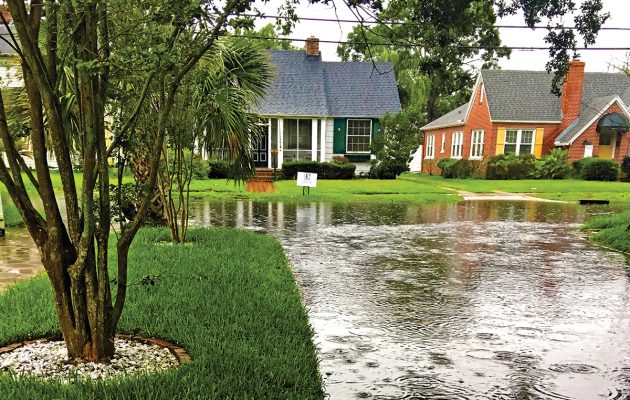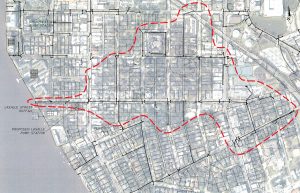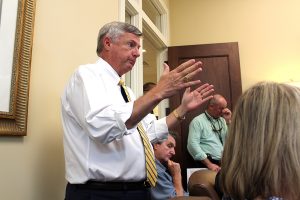Street flooding fix still nearly three years out
Posted on July 1, 2018 By Editor Articles, Neighborhood News, Top Stories


The dashed line shows the drainage divide in the San Marco neighborhood. Moro, Colombo, LaRue and Belmont streets should drain to Landon Park Pump Station after it is completed, while the areas to the north of those streets will drain to the Lasalle Pump Station instead of the Landon Park Pump Station.
With the memories of Hurricane Irma still fresh, some San Marco residents and business owners are nervous about whether the City of Jacksonville is prepared to deal with this year’s hurricane season. A reported one-hour rain event on May 31, which resulted in water levels between 12-18 inches deep on Riviera Street and the surrounding area, has San Marco resident Craig Marlowe and other neighbors concerned.
Approximately 20 residents met with city officials during a special meeting June 14 at First Citizens Bank in San Marco. Representing the City were Lori Boyer, District 5 City Council representative, as well as John Pappas, public works director, and Bill Joyce, public works operations director, who presented diagrams and fielded questions.
The meeting was called in response to localized street flooding caused by a breach in the basin at the corner of Moro and Colombo or some other unknown contributing factor that might have been introduced by drainage improvements elsewhere in the area.
According to Marlowe, the St. Johns River was at low tide when the rain occurred May 31. “Hours later the water levels had still not measurably fallen, and the storm drain inlets were still overflowed at 10 a.m. the next day,” Marlowe complained in an email sent to Pappas.

Matt Carlucci, former City Council member and State Farm Insurance agent, points out the financial effects of flooding to City representatives and neighbors.
Alicia MacLean, who only recently was able to get back into her newly-restored home on Moro Avenue after Hurricane Irma, is also upset. “The [May 31] rains again flooded the streets terribly, and the water was coming up out of the drains,” she informed Boyer in an email.
“We all need a clear explanation of how every recent rain event, heavy or minor, has resulted in flooding,” Marlowe said during the meeting.
MacLean agreed. “There is an issue which needs to be explored before we get any significant rainfall,” she said.
Pappas acknowledged that a solution to flooding has been more difficult and will take longer than anticipated. “I wish the problem were just a broken pipe,” Pappas said. “The problem is more difficult than that because the streets reporting the worst problem with flooding are located at the lowest point in the area.”
“My backyard today has water sitting in it,” said Steve Costas, who lives on Colombo Street. “I’m getting ready to replace my duct for the third time.”

Lori Boyer, Jerry and Elizabeth Harty, Alicia MacLean and Jose Vasquez, at a June 14 meeting where MacLean told the group she had installed a sump pump that was supposed to come on just during heavy rains, “but now any time it rains at all the sump pump runs every 90 seconds.”
Pappas’ enlarged maps of the neighborhood illustrated why water pools at Riviera and Colombo streets, the area east of European Street Cafe across San Marco Boulevard. Currently, the Children’s Way and Landon Park storm-water pump stations serve the San Marco neighborhood.
“Originally, we thought the Moro and Colombo drainage systems only flowed to Landon Street and out to the St. Johns River,” Pappas said. “Consequently, we put in a Tide-Flex valve in the Landon Park system to eliminate high tide flooding of the area.”
When the neighborhood continued to experience flooding, Public Works did a more extensive investigation and discovered the tides were making their way up through a second connection to the area, from the LaSalle system, making the Tide-Flex valve of no use. The LaSalle system is currently an outfall, meaning there is no pump station to push high water out to the river.
According to an article in City Council District 5 News (Jan. 22, 2018), an online newsletter distributed by Boyer to her constituents, last year the City acquired a vacant lot on LaSalle Street in preparation for the construction of a long-contemplated pump station. The project was first planned and partially funded seven years ago, but during the recession funding was reallocated to allow completion of an overbudget project in progress.

Ruler indicates 8 inches of water on Riviera Street after one hour of rain on May 31. (Photo by Craig Marlowe)
The proposed LaSalle Street pump station is now back in line and a portion of the required funding was allocated this year with the remainder programmed over the next two years to support the construction phase.
“Public Works is developing plans for the planned Lasalle Street pump station to collect storm water from Moro, Colombo, LaRue and Belmont Streets,” Pappas said. “Our goal is to go to design-build when design gets to 30 percent, which will take until the end of 2018. This will be an $8 million project. Completion of the pump station is probably two to three years away.” Design-build is a construction project delivery system where the same contractor handles both the design and the construction services of the project.
In the meantime, Pappas told the group that the City would make it a top priority to send a truck out to unclog drains whenever flooding occurs.
“The reality we all have to deal with is that the river is rising and that makes a difference at high tide in the neighborhoods along the river,” Pappas warned. “The City’s bulkhead is at three and a half feet, but most of the property on the river is private, and we can’t make those homeowners build higher bulkheads.”
“The rising water levels are why new construction must be built eight feet off the ground,” Boyer added.
That doesn’t help homeowners living in historic home along the river, however. “I really hate moving inland, but water seems to be the evil element now,” said one neighborhood homeowner, who wished to remain anonymous because she fears flooding issues will negatively affect home values. “We’ve decided to move, but with the discussion by Public Works at the June neighborhood meeting, we are undecided about where to buy.”
By Karen J. Rieley
Resident Community News




 (No Ratings Yet)
(No Ratings Yet)




